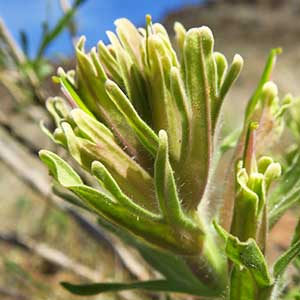Castilleja xanthotricha
Castilleja crista-galli
John Day or yellow-hairy paintbrush, John Day paintbrush, yellow hair paintbrush, yellow-hair Indian paintbrush
cock's-comb paintbrush, mountainside Indian paintbrush
few to several, ± decumbent to erect or ascending, unbranched, sometimes with short, leafy axillary shoots, hairs erect to spreading, long, soft, eglandular, mixed with short stipitate-glandular ones.
few to several, erect or ascending, unbranched or branched, sometimes with short, leafy axillary shoots, hairy, sometimes glabrate proximally, hairs spreading to retrorse, medium length to long, soft, eglandular, often mixed distally with shorter stipitate-glandular ones.
green, linear, lanceolate to broadly lanceolate, oblong, or cuneate, 0.8–5 cm, not fleshy, margins plane to wavy, involute, 0–5-lobed, apex acute, sometimes rounded;
lobes spreading, linear, arising below mid length, nearly as broad as center lobe, apex acute.
green, linear to narrowly lanceolate, 2–8 cm, not fleshy, margins plane, involute, 0–5-lobed, apex acute;
lateral lobes spreading, linear, apex acuminate.
3–14 × 1.5–4.5 cm;
bracts proximally greenish, rarely dull reddish purple, distally white to cream, rarely pale yellow or dull, pale pink (sharply differentiated from proximal coloration), lanceolate or oblong to narrowly ovate, (3–)5–7-lobed;
lobes ascending, linear to obovate, ± broadened distally, medium, long, proximal lobes arising below mid length, central lobe apex broadly rounded to truncate, others acute to rounded.
3–6(–11) × 1.5–6.5 cm;
bracts proximally greenish, distally red, red-orange, or orange, sometimes yellow or dull salmon, narrowly to broadly lanceolate or oblong, 3–5-lobed;
lobes ascending-spreading, linear-lanceolate, long, arising below mid length, central lobe apex rounded to obtuse, lateral ones acute.
curved, 17–23 mm;
tube 15–19 mm;
beak exserted, adaxially green, 5–8(–9) mm, puberulent, stipitate-glandular;
abaxial lip deep purple (color sometimes visible through calyx), green, pinkish, or pale yellow, ± prominent, slightly inflated, usually hidden in calyx, sometimes right at top of calyx, 2 mm, ca. 50% as long as beak;
teeth ascending, whitish, yellowish, pink, or green, 1–1.5 mm.
straight, (25–)30–40(–45) mm;
tube 15–20 mm;
abaxial lip visible through front cleft, beak long-exserted from calyx;
beak adaxially green or yellow-green, 16–21 mm;
abaxial lip proximally white or yellow-green, distally green, reduced, usually visible in front cleft, 3 mm, 20% as long as beak;
teeth incurved to ascending, green, 1 mm.
colored as bracts, 15–26 mm;
abaxial and adaxial clefts 3.5–7 mm, 25–50% of calyx length, deeper than laterals, lateral 2–5 mm, 12–25% of calyx length;
lobes linear, oblong, or narrowly triangular, center lobe apex usually rounded, lobes acute to rounded.
colored as bracts, (20–)25–35 mm;
abaxial and adaxial clefts (6–)10–17 mm, 50% of calyx length, deeper than laterals, lateral (1–)3–6(–10) mm, 35% of calyx length;
lobes slender, triangular, apex acute.
= 48.
= 96.
Castilleja xanthotricha
Castilleja crista-galli
Castilleja xanthotricha is endemic to moderate elevations in the sagebrush hills of the John Day River drainage in north-central Oregon. N. H. Holmgren (1971) hypothesized that this tetraploid species is of allopolyploid hybrid origin between C. glandulifera and C. oresbia.
(Discussion copyrighted by Flora of North America; reprinted with permission.)
Castilleja crista-galli is found in the Rocky Mountains of southwestern Montana and northwestern Wyoming. The extent of its distribution into adjacent Idaho is unresolved, in part because it is frequently confused with either C. linariifolia or C. miniata. Castilleja crista-galli appears to be morphologically intermediate between them, leading to speculation that it might be an allopolyploid derivative. A DNA study (S. Matthews and M. Lavin 1998) showed little support for a hybrid origin. Castilleja crista-galli may be separated with some difficulty from the other two species by the presence of at least some short hairs on the stems and the frequently three- to five-parted leaves. Castilleja linariifolia and C. miniata both usually have subglabrous stems and entire leaves, sometimes three-parted distally, near the inflorescence.
(Discussion copyrighted by Flora of North America; reprinted with permission.)
